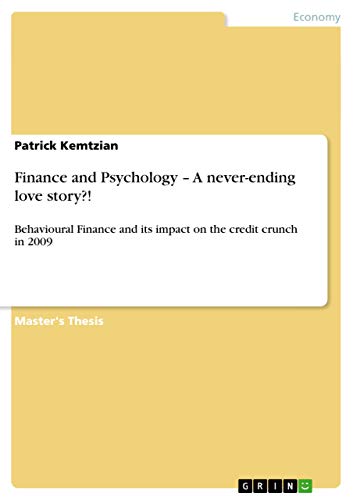Items related to Finance and Psychology - A never-ending love story?!:...
Finance and Psychology - A never-ending love story?!: Behavioural Finance and its impact on the credit crunch in 2009 - Softcover

"synopsis" may belong to another edition of this title.
- PublisherGrin Verlag
- Publication date2012
- ISBN 10 3656271518
- ISBN 13 9783656271512
- BindingPaperback
- Number of pages60
Buy New
Learn more about this copy
Shipping:
US$ 24.50
From Germany to U.S.A.
Top Search Results from the AbeBooks Marketplace
Finance and Psychology ¿ A never-ending love story?!
Book Description Taschenbuch. Condition: Neu. This item is printed on demand - it takes 3-4 days longer - Neuware -Master's Thesis from the year 2009 in the subject Business economics - Business Management, Corporate Governance, grade: 1,2, University of St Andrews, language: English, abstract: In the last decades many financial crises have emerged, like the stock crash of 1987, the Asian crisis in 1997 and the global financial crisis that started in 2008. Although those crises occurred for different reasons, they all proved financial markets to be inefficient. Not all traders think rationally. Behavioural patterns cause irrationality amongst traders. Even after decades of research in this field, financial crises like the latest one in 2008 still develop out of a combination of different behavioural patterns like herding. As a consequence those patterns deserve an in-depth analysis that is conducted by the author in this work.In order to find out to what extent behavioural finance influences the decision -making process of traders and investors the seven most relevant behavioural patterns have been identified and analysed through qualitative research in form of primary research. The informal interview with the sophisticated trader Thomas Vittner serves as empirical evidence for the significance of the determined behavioural patterns. To find out, whether public investors and traders showed a herding behaviour towards analysts' stock recommendations in the financial crisis and its recovery, quantitative research has been made by conducting an experiment. Stocks performances in relation to analysts' recommendations were analysed and evaluated.The author's selected behavioural patterns are influencing traders' and investors' decision-making processes to a large extent as their majority trades irrationally. The herding behaviour to follow analysts' stock recommendations only holds partially in the crisis and in the recovery phase. The results show that whereas 100% of analysts' recommendations matched with market trends before the crisis, only 50% matched during the crisis and its recovery. People tended to follow the general signals of the market, rather than to recommendations given by analysts. 60 pp. Englisch. Seller Inventory # 9783656271512
Finance and Psychology ¿ A never-ending love story?! : Behavioural Finance and its impact on the credit crunch in 2009
Book Description Taschenbuch. Condition: Neu. Druck auf Anfrage Neuware - Printed after ordering - Master's Thesis from the year 2009 in the subject Business economics - Business Management, Corporate Governance, grade: 1,2, University of St Andrews, language: English, abstract: In the last decades many financial crises have emerged, like the stock crash of 1987, the Asian crisis in 1997 and the global financial crisis that started in 2008. Although those crises occurred for different reasons, they all proved financial markets to be inefficient. Not all traders think rationally. Behavioural patterns cause irrationality amongst traders. Even after decades of research in this field, financial crises like the latest one in 2008 still develop out of a combination of different behavioural patterns like herding. As a consequence those patterns deserve an in-depth analysis that is conducted by the author in this work.In order to find out to what extent behavioural finance influences the decision -making process of traders and investors the seven most relevant behavioural patterns have been identified and analysed through qualitative research in form of primary research. The informal interview with the sophisticated trader Thomas Vittner serves as empirical evidence for the significance of the determined behavioural patterns. To find out, whether public investors and traders showed a herding behaviour towards analysts' stock recommendations in the financial crisis and its recovery, quantitative research has been made by conducting an experiment. Stocks performances in relation to analysts' recommendations were analysed and evaluated.The author's selected behavioural patterns are influencing traders' and investors' decision-making processes to a large extent as their majority trades irrationally. The herding behaviour to follow analysts' stock recommendations only holds partially in the crisis and in the recovery phase. The results show that whereas 100% of analysts' recommendations matched with market trends before the crisis, only 50% matched during the crisis and its recovery. People tended to follow the general signals of the market, rather than to recommendations given by analysts. Seller Inventory # 9783656271512

